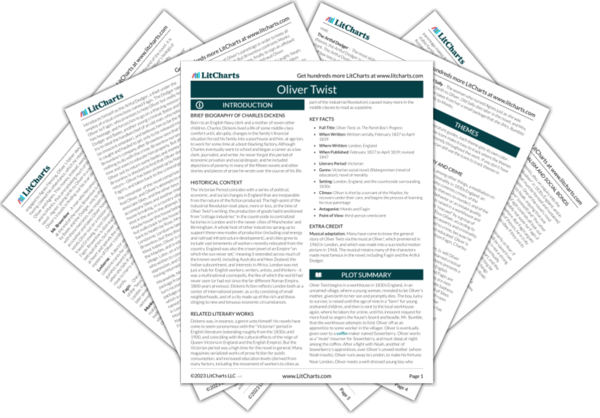Welcome to the LitCharts study guide on Charles Dickens's Oliver Twist. Created by the original team behind SparkNotes, LitCharts are the world's best literature guides.
Oliver Twist: Introduction
A concise biography of Charles Dickens plus historical and literary context for Oliver Twist.
Oliver Twist: Plot Summary
A quick-reference summary: Oliver Twist on a single page.
Oliver Twist: Detailed Summary & Analysis
In-depth summary and analysis of every chapter of Oliver Twist. Visual theme-tracking, too.
Oliver Twist: Themes
Explanations, analysis, and visualizations of Oliver Twist's themes.
Oliver Twist: Quotes
Oliver Twist's important quotes, sortable by theme, character, or chapter.
Oliver Twist: Characters
Description, analysis, and timelines for Oliver Twist's characters.
Oliver Twist: Symbols
Explanations of Oliver Twist's symbols, and tracking of where they appear.
Oliver Twist: Literary Devices
Oliver Twist's key literary devices explained and sortable by chapter.
Oliver Twist: Theme Wheel
An interactive data visualization of Oliver Twist's plot and themes.
Brief Biography of Charles Dickens
Born to an English Navy clerk and a mother of seven other children, Charles Dickens lived a life of some middle-class comfort until, abruptly, changes in the family's financial situation forced his family into a poorhouse and him, at age ten, to work for some time at a boot-blacking factory. Although Charles eventually went to school and began a career as a law clerk, journalist, and writer, he never forgot this period of economic privation and social despair, and he included depictions of poverty in many of the fifteen novels and other stories and pieces of prose he wrote over the course of his life.
Get the entire Oliver Twist LitChart as a printable PDF.

Historical Context of Oliver Twist
The Victorian Period coincides with a series of political, economic, and social changes in England that are inseparable from the nature of the fiction produced. The high-point of the Industrial Revolution took place, more or less, at the time of Oliver Twist's writing; the production of goods had transitioned from "cottage industries" in the countryside to centralized factories in London and in the newer cities of Manchester and Birmingham. A whole host of other industries sprang up to support these new modes of production (including coal energy and railroad infrastructure development), and cities grew to include vast tenements of workers recently relocated from the country. England was also the crown jewel of an Empire "on which the sun never set," meaning it extended across much of the known world, including Australia and New Zealand, the Indian subcontinent, and interests in Africa. London was not just a hub for English workers, writers, artists, and thinkers—it was a multinational cosmopolis, the like of which the world had never seen (or had not since the far different Roman Empire, 1800 years previous). Dickens fiction reflects London both as a center of international power, as a city consisting of small neighborhoods, and of a city made up of the rich and those clinging to new and tenuous economic circumstances.
Other Books Related to Oliver Twist
Dickens was, in essence, a genre unto himself: his novels have come to seem synonymous with the "Victorian" period in English literature (extending roughly from the 1830s until 1900, and coinciding with the cultural effects of the reign of Queen Victoria in England and the English Empire). But the Victorian period was a high time for the novel in general. Many magazines serialized works of prose fiction for public consumption, and increased education levels (derived from many factors, including the movement of workers to cities as part of the Industrial Revolution) caused many more in the middle classes to read as a pastime.
Key Facts about Oliver Twist
- Full Title: Oliver Twist, or, The Parish Boy's Progress
- When Written: Written serially, February 1837 to April 1839
- Where Written: London, England
- When Published: February 1837 to April 1839; revised 1847
- Literary Period: Victorian
- Genre: Victorian social novel; Bildungsroman (novel of education); novel of morality
- Setting: London, England, and the countryside surrounding, 1830s
- Climax: Oliver is shot by a servant of the Maylies; he recovers under their care, and begins the process of learning his true parentage
- Antagonist: Monks and Fagin
- Point of View: third-person omniscient
Extra Credit for Oliver Twist
Musical adaptation. Many have come to know the general story of Oliver Twist via the musical Oliver!, which premiered in 1960 in London, and which was made into a successful motion picture in 1968. The musical retains many of the characters made most famous in the novel, including Fagin and the Artful Dodger.












